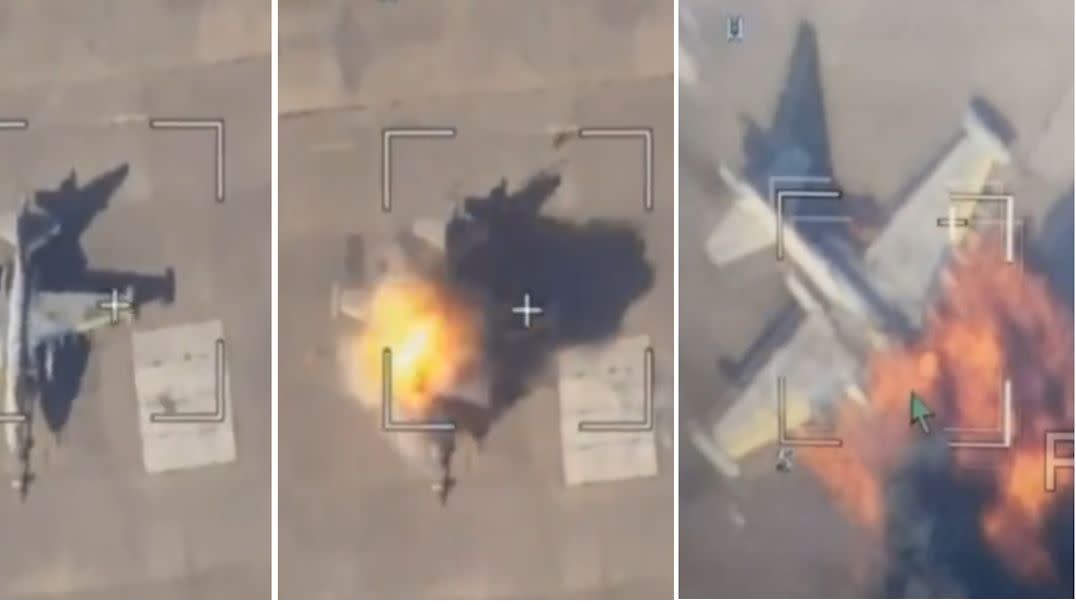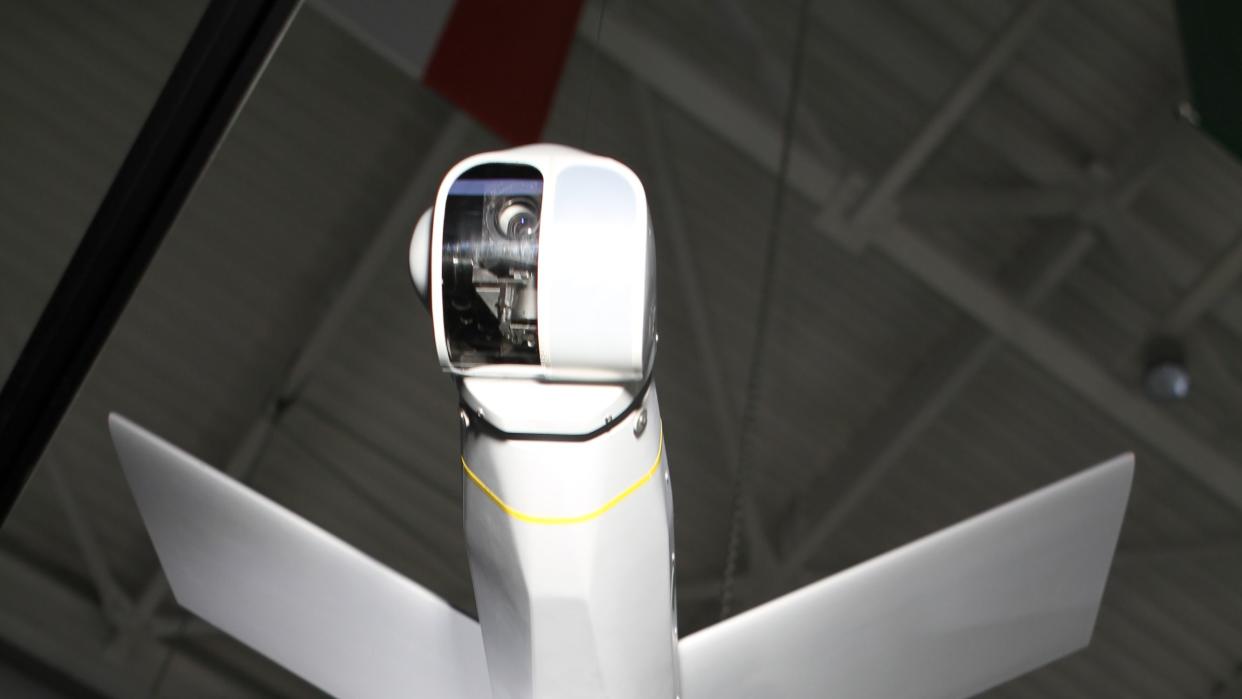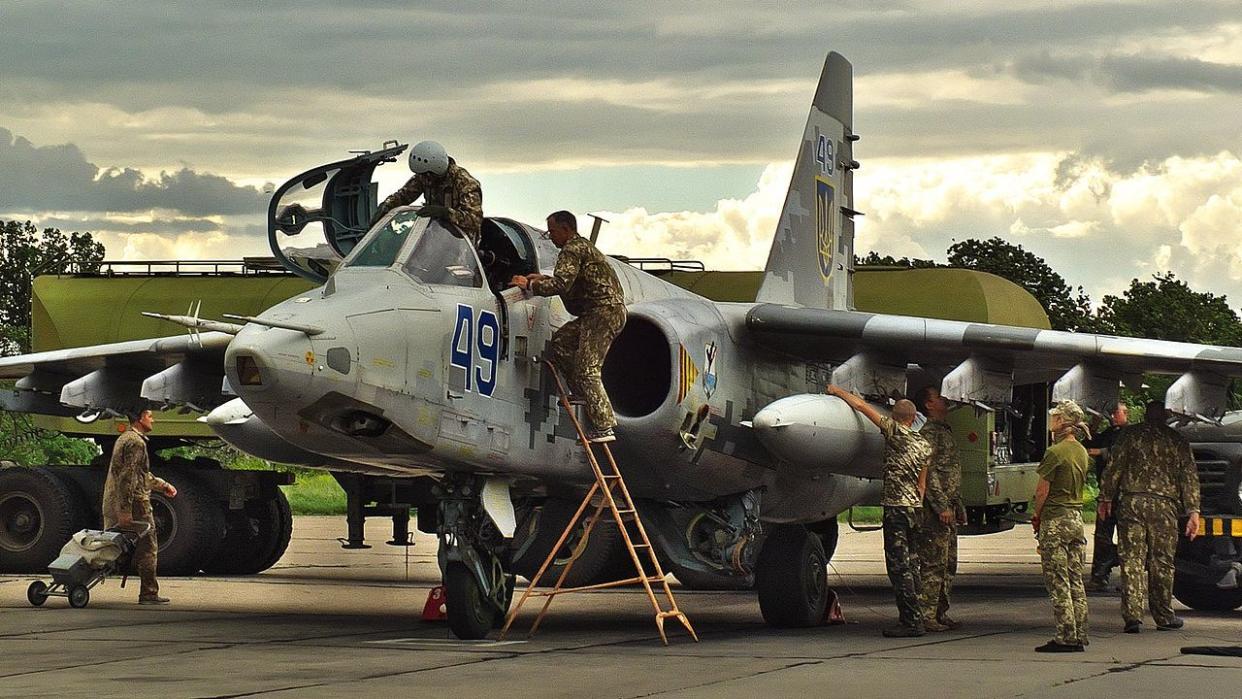Ukraine’s Air Force Has a Big Kamikaze Drone Problem

A video that made its way to Russian social media last month reveals that a second Ukrainian warplane has been struck by a Russian kamikaze drone while at an airbase. And unlike the first recording released, this strike clearly destroyed its target—an Su-25 Frogfoot ground attack jet of Ukraine’s 299th Tactical Aviation Brigade.
The recording shows footage from the forward-looking camera of what appears to be a Lancet-3 kamikaze drone diving towards the Ukrainian jet, which was parked at Dolgintsevo airbase near Kryvhi Rhi. There’s also footage from a second drone observing the strike—likely an Orlan-10, or similar surveillance aircraft.
The Lancet plummets squarely into the Frogfoot jet and explodes, causing a fire that eventually consumes the jet.
#Ukraine: A Ukrainian Su-25 close air support aircraft was destroyed by a Russian Lancet loitering munition at the airfield of Kryvyi Rih.
This is the second aircraft known to be targeted on this airfield by Russian loitering munitions. pic.twitter.com/5E2RuBZPNb— 🇺🇦 Ukraine Weapons Tracker (@UAWeapons) October 10, 2023
Prior footage released on September 19 shows another Lancet strike on the same airbase, which smashed into the ground just next to the cockpit of a MiG-29 tactical fighter and caused significant damage—at minimum.
Very interesting video of a Ukrainian MiG-29 fighter jet based at the Dolgintsevo Air Base near Kryvyi Rih being struck by a Russian ZALA Lancet loitering munition.
The airframe appeared to be operational, though it can be concluded from the video that it suffered only minor… pic.twitter.com/jZDYZ5rukq— Status-6 (Military & Conflict News) (@Archer83Able) September 19, 2023
It’s likely (but isn’t confirmed) that the more recently released footage also dates back to September, due to the similar-looking condition of the airfield.
Indeed, on September 11, Russian stated media claimed that its Aerospace Force had destroyed two Ukrainian MiG-29s and three Su-25s at this airbase. While Russia’s claims are usually dubiously over-inflated, this particular claim could refer to that incident.
If—contrary to the above assumption—the new footage comes from a separate strike in October, that would represent a more serious failure of Ukraine’s air force to adapt to the initial attack.
Some have also argued that the destroyed Su-25 might be an elaborate decoy, but nothing in the footage supports that interpretation.
Lancet and Orlan: Drone Tag Team
Russia’s Lancet-3 kamikazes and Orlan-10 surveillance drones usually fight as a team on the frontline. The longer-endurance Orlan-10s help locate targets for the short-range Lancets to attack, and then loiter around to observe the attack and assess damaged to the target. Olran-10s may also serve as relays to extend the remote-control range of Lancet drones.
But this strike was anything but typical—even the large Project 51 Lancet-3s are believed to have a strike range of just 25 miles, and Dolgintsevo is located 45-50 miles away from Russian-controlled territory on the other side of the Dnipro River.
Perhaps a specially modified Project 51 Lancet or the latest Project 53 Lancet was used.
The Russian state media reporter posting the video claims that a range of 75 miles has been achieved by new Lancets. Other sources, however, claim the increase is to 44 miles, which might be just barely adequate to reach the base.
The Russian Defense Company, ZALA Aero Group which Produces the Lancet “Kamikaze” Attack Drone is in the process of Developing and Testing a New Variant of the Drone which is currently called the “Product-53” and is claimed to be capable of being Remotely fired from a… pic.twitter.com/Gax0Rv4bpB
— OSINTdefender (@sentdefender) July 17, 2023

Alternately, reducing the weight of the Project 51’s 6.6-pound warhead could have increased range—though that would come at the cost of requiring greater precision due to the smaller blast.
Could Russia have used some other drone? Certainly, Russia’s Iranian-supplied Shahed kamikaze drones could easily reach Dolgintsevo, but they are usually pre-targeted to fixed satellite-navigation coordinates and aren’t precise enough to pick off individual aircraft. The drone’s X-shaped shadow seen in the attack may also suggest the use of some new long-range quadcopter drone, but the Lancet-3 also has an X-shaped profile.
It’s undoubtedly bad news for Ukraine’s air force and other operational-depth support units (artillery, air defense, HQs, logistics), which now may be at risk of Russian precision strikes up to 50 miles (or worse, 75 miles) depth from the frontline. That said, it’s not clear whether Russia can yet sustain such longer-range Lancet strikes, or if the attacks were undertaken by still limited-volume Project 53 prototypes or field modifications.
Ukraine’s Frogfoot Fleet

The destroyed Sukhoi Su-25 Frogfoot (also known as the Grach ie. “Rook”) is an armored Soviet-built ground-attack jet with a large 30-millimeter gatling cannon intended to support frontline ground troops. Though similar conceptually to the U.S. Air Force’s A-10 Thunderbolt jet, the Frogfoot is lighter and faster. It also usually relies on unguided bombs and rockets, rather than the A-10’s Hellfire guided anti-tank missiles.
The 299th Tactical Brigade counted 19 single-seat Su-25s and five two-seat Su-25UBM combat-capable trainers pre-war, with another 15 or so Su-25s in storage. All but one of these Frogfoots had been modernized to the M1 life-extended standard (new satellite navigation, digital targeting systems, and modernized radios and flight recorders), and a few were modernized to the further-improved M1K model—which added KUV 26-50-01 flare decoy dispenser to divert heat-seeking missiles.
Close air support is a dangerous mission, and since hostilities began, the 299th took losses equal to two thirds of its starting strength (16 aircraft) to Russian fighters and ground-based air defenses. However, the unit has been able to regenerate numbers thanks to 14 Su-25s donated by Bulgaria and 4 more from North Macedonia. It’s also likely that Ukraine has managed to restore some of its Su-25s in storage to operational condition.
These days, the 299th Brigade’s Su-25s are mostly used to provide rapid-response area bombardments on Russian positions and troop concentrations. They fly at extremely low altitude to mask themselves against radars, then abruptly nose upwards to launch their unguided rockets in an arc at several miles standoff from the target (rather than in the direct-fire mode they were designed for). This reduces their exposure to short-range air defenses.
Both the Su-25 and MiG-29 were designed to fly from rough frontline airstrips. This allows forward-deployed aircraft to quickly get to the combat zone while carrying more weapons, while also spending less time airborne and exposed to detection by Russian long-range radars—particularly on Russian Su-35S jets, MiG-31BM jets, and A-50 Mainstay airborne early warning planes.
But as they may now fall within range of precision attacks by Lancet drones, Ukraine’s air force must balance these significant efficiencies against the heightened risk of losing aircraft on the ground.
Kyiv’s Drone Defense Dilemma
The Lancet drone has proven to be Russia’s most effective weapon for targeting Ukraine’s deadly Western-supplied long-range artillery, as they can be remotely controlled for short missions and attack relatively precisely (even if misses are not uncommon). If they can now fly far enough to hit bases for Ukrainian short-range fighters, that poses a grave problem.
Prior to the recent attacks, there was confirmation of just four Ukrainian jets destroyed on the ground (2 MiG-29s, an Su-27 fighter and an Su-24 bomber) to Russian missile strikes in the war’s first year and a half.
This is far more limited success than expected pre-war—attributable to the UAF’s rapid redeployment and dispersal of aircraft at the war’s onset, timely early warning of incoming attack (since then likely facilitated by NATO air surveillance assets), and Russia’s generally poor-quality real-time reconnaissance capabilities deeper into Ukrainian territory.
Thus, the two aircraft struck by Lancets are a sting Ukraine’s fleet of an estimated 100 or so still-operational combat jets.
To be sure, even the short-ranged MiG-29 and Su-25 easily have enough fuel to reach combat zones if deployed, say, 100 miles further back to avoid Lancet strikes. But doing so will require reduced combat payloads, invite greater risk of earlier detection by patrolling Russian fighters in transit to the combat zone, and increase the danger of crowding at the ‘medium-range’ bases (which, in turn, could make the craft more vulnerable to future Russian strikes).

Ukraine could, instead, improve short-to-medium range air defenses around its frontline airbases to more reliably detect and destroy small drones. Unfortunately, such valuable defense are very in-demand everywhere in Ukraine—they are used to defend both civilians and frontline troops—so there are unavoidable tradeoffs. Besides, defenses against such small targets have never been foolproof, as the targets can be tricky to detect.
Ukraine might also work on ensuring that parked aircraft are camouflaged or concealed in hangars, or deploy decoys to absorb additional Russian attacks. Even overhead “umbrellas” or nets could obscure a plane’s exact position and prematurely trigger the fuses of the shaped charges warheads used on many kamikaze drones.
As it seems likely (though still uncertain) that the strike on the Su-25 also occurred in September, Ukraine may already have undertaken countermeasures to avoid a repeat of this incident. The effectiveness of those countermeasures—and the extent to which enhanced range Lancets are available—will determine whether these successful strikes prove to be one-off events, or continue to exact a toll on the UAF’s operational fleet.
You Might Also Like
